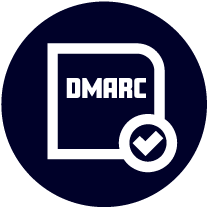Utilisez le vérificateur d’enregistrements DKIM pour valider
vos enregistrements DKIM
DKIM (DomainKeys Identified Mail) est une technique d’authentification des e-mails qui permet au destinataire de vérifier qu’un e-mail a bien été envoyé et autorisé par le propriétaire du domaine d’envoi. Ce système fonctionne conjointement avec le protocole DMARC.
Vous avez besoin d’un enregistrement DKIM valide pour mettre en œuvre le protocole. L’outil de vérification de Mimecast utilisera le nom de domaine et le sélecteur pour déterminer s’il existe un enregistrement DKIM valide et publié. Étant donné que ce protocole authentifie la réputation et l’identité de l’expéditeur, nous vous recommandons de tester minutieusement toutes modifications de l’enregistrement DKIM avant de les appliquer.
Vos résultats
Votre enregistrement DNS est :
Votre enregistrement DNS est :
Sélecteur
Votre sélecteur est :
Domaine
Votre domaine est :
Enregistrement DKIM complet
Longueur de la clé
La plupart des ESP utilisent des clés de 1024 bits par défaut, mais des entreprises comme Google utilisent des clés de 2048 bits. Nous vous recommandons d’utiliser des clés de 1024 bits ou plus.
Nous avons détecté que la longueur de clé que vous utilisez est
Declared tags
Defaulted tags
| Tag | Value | Description |
|---|---|---|
| v | Version du protocole DKIM. | |
| g | * | Certaines entreprises confient des tâches métier spécifiques à des groupes distincts, internes ou externes à l’organisation. Cette clé permet d’autoriser un groupe à signer certains messages, tout en limitant les signatures qu’il peut générer. La granularité DKIM (la balise g=) facilite ce type de restriction d’autorisation. |
| h | La balise h= fournit une liste de mécanismes qui peuvent être utilisés pour produire un condensé des données du message. (sha1 ou sha256 peuvent être utilisés). | |
| k | La balise k= fournit une liste de mécanismes qui peuvent être utilisés pour décoder une signature DKIM. (rsa est le plus souvent utilisé). | |
| n | Notes susceptibles d’intéresser un être humain. | |
| p | Votre clé publique encodée en base64. | |
| s | * | Le ’s=’ fournit une liste des types de service auxquels ce sélecteur peut s’appliquer. (* et email sont utilisés le plus souvent). |
| t | La balise t= fournit une liste d’indicateurs permettant de modifier l’interprétation du sélecteur. Ces indicateurs du sélecteur DKIM sont facultatifs. (y et s sont souvent utilisés). | |
| l | 0 | Les limites de longueur du corps (sous la forme de la balise l=) font l’objet de plusieurs attaques potentielles. |
| q | La balise q= fournit une liste de méthodes de requête. (dns est le plus souvent utilisé) |
Souhaitez-vous que vos résultats vous soient envoyés par e-mail ?
Merci.
Consultez votre boîte de réception pour connaître les détails de votre demande.







